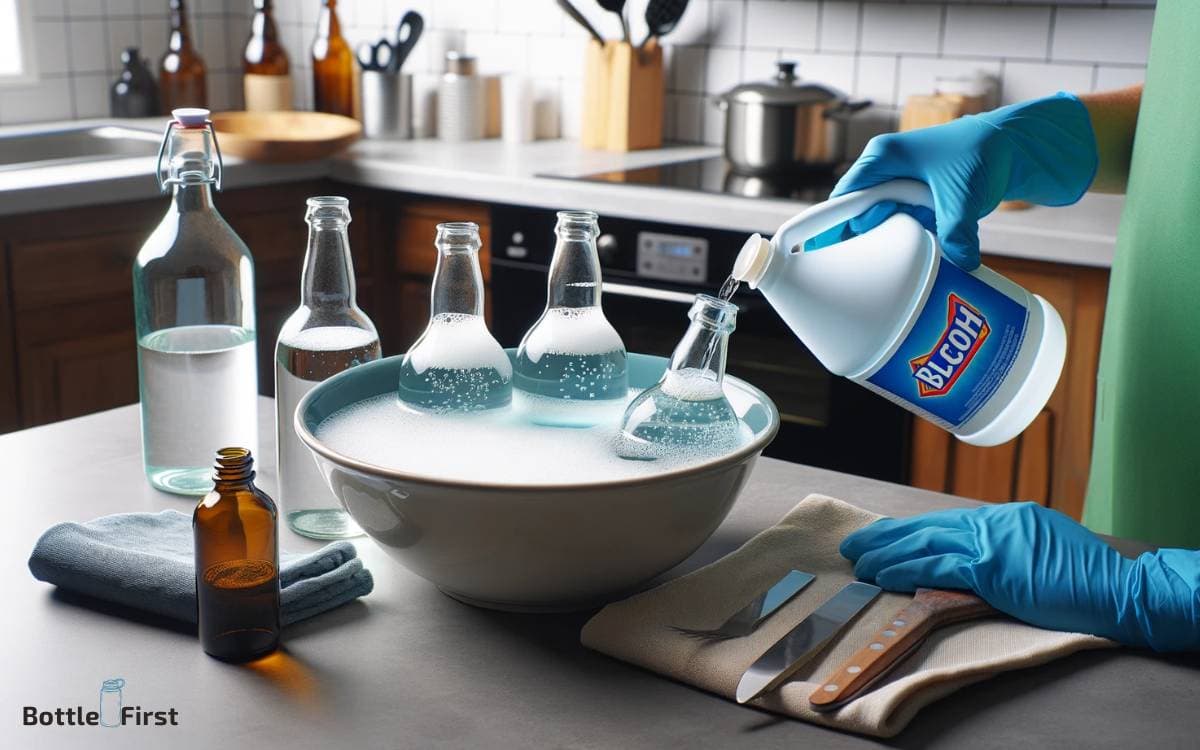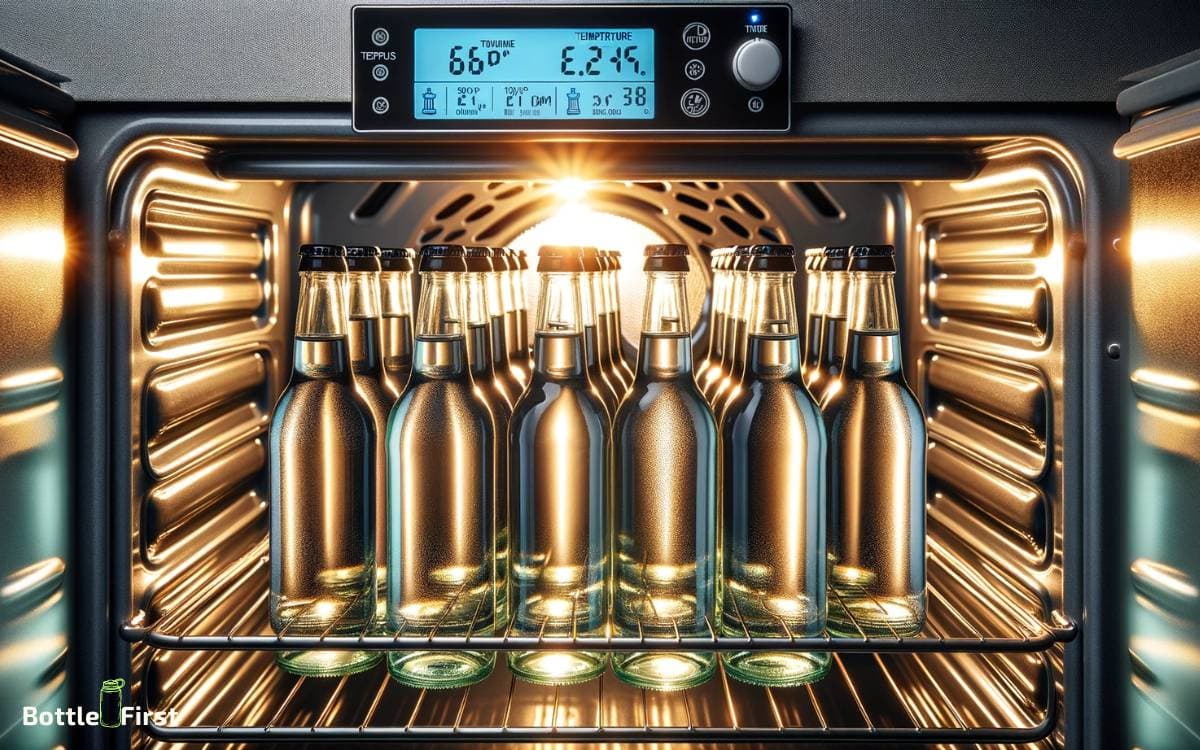How to Sterilize Glass Bottles for Alcohol? Quick Methods!
Sterilizing glass bottles for alcohol is essential for ensuring your spirits are safe and taste great.
The process involves thoroughly cleaning the bottles and then using a method such as boiling, oven sterilization, chemical sterilization with a solution like Star San, or using a dishwasher with a high-temperature and sanitize cycle.
Each method effectively kills any bacteria or yeast that could spoil the alcohol.
Sterilization is a critical step in the bottling process for homemade alcohol to prevent contamination.
Here are some quick methods:
Ensure bottles are completely dry before use to avoid diluting the alcohol.
Ensure your homemade spirits are impeccably prepared by mastering the art of glass bottle sterilization with these easy-to-follow methods.
Key Takeaway
Importance of Sterilizing Glass Bottles
To ensure the safety and quality of your alcohol, sterilizing glass bottles is essential. Using clean, sterilized bottles prevents contamination and ensures that your alcohol remains pure and unaltered.
Innovation in alcohol production demands a meticulous approach to hygiene, and sterilizing glass bottles is a crucial part of this process.
By sterilizing your bottles, you create an environment that’s unfriendly to harmful bacteria and other contaminants, ultimately preserving the integrity of your alcohol.
Proper sterilization also extends the shelf life of your product, allowing you to maintain its quality over time.
Now that you understand the importance of sterilizing glass bottles, let’s explore the materials needed for this crucial step in alcohol production.
Materials Needed for Sterilization
You will need a few specific materials to effectively sterilize glass bottles for alcohol.
First, gather some dish soap, a bottle brush, and hot water for initial cleaning. Next, acquire a large pot or a water bath canner to submerge the bottles in boiling water.
Additionally, you’ll need some clean towels or a drying rack to air dry the bottles after sterilization.
To ensure thorough sterilization, consider using a no-rinse sanitizer such as Star San or Iodophor, which are effective and safe for sterilizing glass bottles.
These materials are essential for maintaining a sanitized environment and preventing any contamination when preparing glass bottles for alcohol.
Boiling Method for Sterilization
After cleaning the glass bottles with hot water and dish soap, you’ll then proceed to sterilize them using the boiling method.
This method is straightforward and effective, ensuring that the bottles are free from any harmful microorganisms.
Here are a few innovative tips to enhance the boiling method for sterilization:
- Utilize a steaming basket to sterilize multiple bottles simultaneously.
- Try adding a few drops of essential oils to the boiling water for a natural antibacterial boost.
- Consider using a digital thermometer to ensure the water reaches the optimal sterilization temperature.
By incorporating these innovative approaches, you can maximize the effectiveness of the boiling method for sterilizing glass bottles.
Once the bottles are sterilized, it’s time to explore the next method of sterilization using a bleach solution.
Bleach Solution for Sterilization
Once the bottles have been sterilized using the boiling method, you’ll proceed to prepare a bleach solution for further sterilization.
To do this, mix one tablespoon of bleach with one gallon of water in a clean container. Ensure the bleach contains 5-6% sodium hypochlorite for effective sterilization.
After preparing the solution, carefully submerge each bottle into the bleach solution, ensuring they’re completely filled and then let them soak for at least 2 minutes.
Once the bottles have been submerged for the appropriate time, remove and rinse them thoroughly with clean water.
The bleach solution will effectively kill any remaining bacteria or contaminants, ensuring your glass bottles are fully sterilized and ready for use.
Now, let’s move on to the next sterilization method, the oven sterilization method.
Oven Sterilization Method
Using a solution of one tablespoon of bleach mixed with one gallon of water, you’ll have thoroughly sterilized the glass bottles; now let’s explore the oven sterilization method.
To innovate your sterilization process, consider the following tips for oven sterilization:
- Preheat the oven to 320°F (160°C) to ensure proper sterilization without damaging the glass bottles.
- Place the clean, empty bottles on a baking sheet, ensuring they aren’t touching each other to allow for even heat distribution.
- Let the bottles bake in the oven for 10 minutes, then carefully remove them using oven mitts to avoid burns.
How to Sterilize Glass Bottles with Vinegar
Sterilizing glass bottles with vinegar is an effective and natural method, especially suitable for those who prefer not to use chemical sterilizers. Vinegar is acidic and can help to kill some bacteria and germs.
Here’s how you can do it:
- Clean the Bottles: Begin by thoroughly cleaning the bottles with warm, soapy water. Use a bottle brush to scrub the inside of the bottles, ensuring all residues are removed. Rinse them well to get rid of any soap residue.
- Prepare a Vinegar Solution: Mix a solution of equal parts water and white vinegar. Vinegar has natural disinfectant properties, but it needs to be diluted to be safe for use on glass.
- Fill the Bottles with Vinegar Solution: Pour the vinegar solution into the bottles, ensuring they are completely filled. If you’re sterilizing multiple bottles, you can also immerse them in a large container filled with the vinegar solution.
- Soak the Bottles: Allow the bottles to soak in the vinegar solution for at least 10 minutes. This duration gives the vinegar enough time to act on any bacteria or germs present.
- Rinse Thoroughly: After soaking, empty the vinegar solution and rinse the bottles thoroughly with clean water. This step is important to ensure that there is no vinegar residue left in the bottles, which could affect the taste of the contents later.
- Dry the Bottles: Allow the bottles to air dry completely. Place them upside down on a clean drying rack in a well-ventilated area.
- Inspect and Store: Once the bottles are dry, inspect them to ensure they are clean and residue-free. Store them in a clean, dry place until they are ready to be used.
Remember, while vinegar is a natural disinfectant, it may not be as effective as boiling or using a commercial sterilizer, especially against certain types of bacteria and viruses.
Therefore, consider the intended use of the bottles and whether a more rigorous method of sterilization might be necessary.
For example, if you’re sterilizing bottles for brewing, winemaking, or storing drinking water, you might need a more effective sterilization method.
Conclusion
Now that you’ve learned how to sterilize glass bottles for alcohol, you can ensure that your homemade concoctions are safe and clean.
Remember, cleanliness is next to godliness, so make sure to sterilize your glass bottles using one of these methods before filling them up with your favorite spirits.
Just like a sparkling clean glass, your sterilized bottles will shine with purity and readiness for your delicious drinks.
Cheers to safe and sanitary storage!





